List of Roman emperors: Difference between revisions
No edit summary |
No edit summary |
||
| Line 4: | Line 4: | ||
[[Image:Statue-Augustus.jpg|thumb|200px|right|Augustus, first Roman Emperor in the Principate Era.]] |
[[Image:Statue-Augustus.jpg|thumb|200px|right|Augustus, first Roman Emperor in the Principate Era.]] |
||
The title of ''Roman Emperor'', although in some ways |
The title of ''Roman Emperor'', although in some ways a Modern Emperor, effectively summarises the position held by those individuals who wielded power in the [[Roman Empire]]. The Roman Empire developed from the [[Roman Republic]] after its ascent to the dominant power in Europe, and is characterised by the concentration of power in one individual, rather than the "Senate and People of Rome". However, [[Augustus Caesar|Augustus]], universally accepted to have been the first emperor, was careful to maintain the facade of republican rule, and took no specific title to mark his rule (which began in 27 BC).<ref name = "holland">Rubicon. Holland, T. Abacus, 978-0349115634</ref> Instead, he simply concentrated the pre-existing powers of [[Roman magistrate]]s upon his own person, taking the existing honorific of '[[Princeps Senatus]]' (the first man of the senate).<ref name="holland"/> This style of government, which lasted for nearly 300 years, is thus called the '[[Principate]]'. The modern word 'emperor' derives from the title '[[Imperator]]', which was granted by an army to a successful general; as such, during the initial phase of the Roman Empire, it still had to be earned by the 'Princeps'. The term 'emperor', though modern, is used when describing rulers of the Roman Empire, since it a) emphasises the strong links between the ruler and the army (on whose support the ruler's power depended), and b) does not discriminate between the style of rule in different phases of the Empire. |
||
In the late 3rd century AD, after the [[Crisis of the Third Century]], [[Diocletian]] formalised and embellished the recent manner of imperial rule, establishing the so-called '[[Dominate]]' period of the Roman Empire. This was characterised by the explicit investment of authority in the person of the Emperor, and the use of the style 'Dominus Noster' ('Our Lord'). From Diocletian onwards, there were often multiple simultaneous emperors, dividing the rule of the vast territories between them. After 395 AD, and the death of [[Theodosius I]], the Empire became more firmly split into [[Western Roman Empire|Western]] and [[Eastern Roman Empire|Eastern]] halves<ref>Chester G. Starr, ''A History of the Ancient World, Second Edition.'' [[Oxford University Press]], 1974. pp. 670–678.</ref> They were not legally separate however, and the Emperor of the more stable Eastern Empire often imposed his authority over the Western half. The Western Empire was heavily troubled after 395 AD, and collapsed completely after 455 AD, the last Western Emperor abdicating in 476 AD; after which the Eastern Empire maintained claim to the territories in the west. The Eastern Empire would continue until 1453, and the capture of [[Constantinople]] by the [[Ottoman Turks]].<ref>Asimov, p. 198.</ref> The Eastern Emperors, generally known in modern times as the [[Byzantine Emperor]]s, continued an unbroken succession of Roman Emperors. The listing of the early Byzantine Emperors in this article ends in the 6th century with [[Justin II]], last of the [[Justinian dynasty]]. |
In the late 3rd century AD, after the [[Crisis of the Third Century]], [[Diocletian]] formalised and embellished the recent manner of imperial rule, establishing the so-called '[[Dominate]]' period of the Roman Empire. This was characterised by the explicit investment of authority in the person of the Emperor, and the use of the style 'Dominus Noster' ('Our Lord'). From Diocletian onwards, there were often multiple simultaneous emperors, dividing the rule of the vast territories between them. After 395 AD, and the death of [[Theodosius I]], the Empire became more firmly split into [[Western Roman Empire|Western]] and [[Eastern Roman Empire|Eastern]] halves<ref>Chester G. Starr, ''A History of the Ancient World, Second Edition.'' [[Oxford University Press]], 1974. pp. 670–678.</ref> They were not legally separate however, and the Emperor of the more stable Eastern Empire often imposed his authority over the Western half. The Western Empire was heavily troubled after 395 AD, and collapsed completely after 455 AD, the last Western Emperor abdicating in 476 AD; after which the Eastern Empire maintained claim to the territories in the west. The Eastern Empire would continue until 1453, and the capture of [[Constantinople]] by the [[Ottoman Turks]].<ref>Asimov, p. 198.</ref> The Eastern Emperors, generally known in modern times as the [[Byzantine Emperor]]s, continued an unbroken succession of Roman Emperors. The listing of the early Byzantine Emperors in this article ends in the 6th century with [[Justin II]], last of the [[Justinian dynasty]]. |
||
Revision as of 23:32, 4 January 2011
- For a simplified list, see Concise list of Roman emperors
- For more information, see History of the Roman Empire.
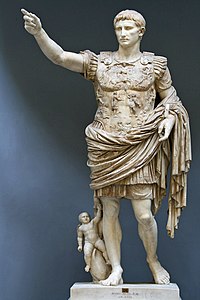
The title of Roman Emperor, although in some ways a Modern Emperor, effectively summarises the position held by those individuals who wielded power in the Roman Empire. The Roman Empire developed from the Roman Republic after its ascent to the dominant power in Europe, and is characterised by the concentration of power in one individual, rather than the "Senate and People of Rome". However, Augustus, universally accepted to have been the first emperor, was careful to maintain the facade of republican rule, and took no specific title to mark his rule (which began in 27 BC).[1] Instead, he simply concentrated the pre-existing powers of Roman magistrates upon his own person, taking the existing honorific of 'Princeps Senatus' (the first man of the senate).[1] This style of government, which lasted for nearly 300 years, is thus called the 'Principate'. The modern word 'emperor' derives from the title 'Imperator', which was granted by an army to a successful general; as such, during the initial phase of the Roman Empire, it still had to be earned by the 'Princeps'. The term 'emperor', though modern, is used when describing rulers of the Roman Empire, since it a) emphasises the strong links between the ruler and the army (on whose support the ruler's power depended), and b) does not discriminate between the style of rule in different phases of the Empire.
In the late 3rd century AD, after the Crisis of the Third Century, Diocletian formalised and embellished the recent manner of imperial rule, establishing the so-called 'Dominate' period of the Roman Empire. This was characterised by the explicit investment of authority in the person of the Emperor, and the use of the style 'Dominus Noster' ('Our Lord'). From Diocletian onwards, there were often multiple simultaneous emperors, dividing the rule of the vast territories between them. After 395 AD, and the death of Theodosius I, the Empire became more firmly split into Western and Eastern halves[2] They were not legally separate however, and the Emperor of the more stable Eastern Empire often imposed his authority over the Western half. The Western Empire was heavily troubled after 395 AD, and collapsed completely after 455 AD, the last Western Emperor abdicating in 476 AD; after which the Eastern Empire maintained claim to the territories in the west. The Eastern Empire would continue until 1453, and the capture of Constantinople by the Ottoman Turks.[3] The Eastern Emperors, generally known in modern times as the Byzantine Emperors, continued an unbroken succession of Roman Emperors. The listing of the early Byzantine Emperors in this article ends in the 6th century with Justin II, last of the Justinian dynasty.
- For further Eastern/Byzantine Emperors, see: List of Byzantine Emperors.
The emperors listed in this article are those generally agreed to have been 'legitimate' emperors (e.g. not usurpers, etc.). However, since the emperorship was rather vaguely defined legally, which persons were 'legitimate' is not easy to define; many of the 'legitimate' emperors accessed to the position by usurpation, and many 'illegitimate' claimants had a legitimate claim to the position. The following criteria can be used to derive the list:
- Any individual who undisputedly ruled the whole Empire, at some point, must, in point of fact, be a 'legitimate emperor'(1).
- Any individual who was nominated as heir or co-emperor by a legitimate emperor (1), and who succeeded to rule in their own right, is a legitimate emperor (2).
- Where there were multiple claimants, and none were legitimate heirs; the claimant accepted by the Roman Senate as emperor is the legitimate emperor (3), at least during the Principate.
So for instance, Aurelian, though acceding to the throne by usurpation, was the sole and undisputed between 274–275 AD, and thus was a legitimate emperor. Gallienus, though not in control of the whole Empire, and plagued by other claimants, was the legitimate heir of (the legitimate emperor) Valerian. Claudius Gothicus, though acceding illegally, and not in control of the whole Empire, was the only claimant accepted by the Senate, and thus, for his reign, was the legitimate emperor. Equally, during the Year of the Four Emperors, all claimants, though not undisputed, were at some point accepted by the Senate and are thus included; conversely, during the Year of the Five Emperors neither Pescennius Niger or Clodius Albinus were accepted by the Senate, and are thus not included. There are a few examples where individuals were made co-emperor, but never wielded power in their own right (typically the child of an emperor); these are legitimate, but are listed together with the 'senior' emperor.
The above formula holds until 395, when the Western and Eastern halves of the Empire split. After that, it continues to hold, with the caveat that a legitimate emperor had undisputed control over one half of the Empire. Towards the end of the Western Empire (after 455), the emperor ceased to be a relevant figure and there was sometimes actually no claimant. For the sake of historical completeness, all Western Emperors after that point are included, even though Romulus Augustus, traditionally the "last Roman Emperor" was technically a usurper.
- For a more exhaustive list of all claimants, including usurpers, see Concise list of Roman Emperors
The Principate
Julio-Claudian dynasty
| Portrait | Name | Born | Reigned | Succession | Died |
|---|---|---|---|---|---|
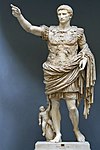
|
Augustus IMPERATOR CAESAR DIVI FILIVS AVGVSTVS |
September 23 63 BC, Rome, Italia | January 16 27 BC – August 19, 14 AD | Became de facto emperor as a result of the 'first settlement' between himself and the Roman Senate. | August 19, 14 AD Natural causes. |

|
Tiberius TIBERIVS CAESAR AVGVSTVS |
November 16 42 BC, Rome | September 18, 14 AD – March 16, 37 AD | Son of Augustus's wife Livia by a previous marriage; adopted son of Augustus. | March 16, 37 AD Probably old age, possibly assassinated |

|
Caligula GAIVS CAESAR AVGVSTVS GERMANICVS |
August 31, 12 AD, Antium, Italia | March 18, 37 AD – January 24, 41 AD | Son of Tiberius's nephew Germanicus. | January 24, 41 AD Assassinated in a conspiracy involving senators and Praetorian Guards. |

|
Claudius TIBERIVS CLAVDIVS CAESAR AVGVSTVS GERMANICVS |
August 1, 10 BC, Lugdunum, Gallia Lugdunensis | January 25/26, 41 AD – October 13, 54 AD | Nephew of Tiberius, brother of Germanicus and uncle of Caligula; proclaimed emperor by the Praetorian Guard. | October 13, 54 AD Probably poisoned by his wife Agrippina the Younger, in favour of her son Nero. |
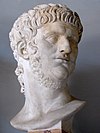
|
Nero NERO CLAVDIVS CAESAR AVGVSTVS GERMANICVS |
December 15, 37 AD, Antium, Italia | October 13, 54 AD – June 11, 68 AD | Grandson of Germanicus, step- and adopted son of Claudius. | June 11, 68 AD Committed suicide after being declared a public enemy by the Senate. |
Year of the Four Emperors and Flavian Dynasty
| Portrait | Name | Born | Reigned | Succession | Died |
|---|---|---|---|---|---|

|
Galba SERVIVS GALBA IMPERATOR CAESAR AVGVSTVS |
December 24 3 BC, Near Terracina, Italia | June 8, 68 AD – January 15, 69 AD | Seized power after Nero's suicide, with support of the Spanish legions | January 15, 69 AD Murdered by Praetorian Guard |
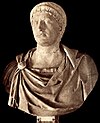
|
Otho MARCVS OTHO CAESAR AVGVSTVS |
April 25, 32 AD, Ferentinum, Etruria, Italia | January 15, 69 AD – April 16, 69 AD | Appointed by Praetorian Guard | April 16, 69 AD Committed suicide after losing Battle of Bedriacum to Vitellius |
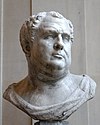
|
Vitellius AVLVS VITELLIVS GERMANICVS AVGVSTVS |
September 24, 15 AD, Rome | April 17, 69 AD – December 20, 69 AD | Seized power with support of German Legions (in opposition to Galba/Otho) | December 20, 69 AD Murdered by Vespasian's troops |
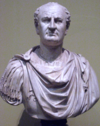
|
Vespasian TITVS FLAVIVS CAESAR VESPASIANVS AVGVSTVS |
November 17, 9 AD, Falacrine, Italia | July 1, 69 AD – June 24, 79 AD | Seized power with the support of the eastern Legions (in opposition to Vitellius) | June 24, 79 AD Natural causes |

|
Titus TITVS FLAVIVS CAESAR VESPASIANVS AVGVSTVS |
December 30, 39 AD, Rome | June 24, 79 AD – September 13, 81 AD | Son of Vespasian | September 13, 81 AD Natural causes (Plague) |

|
Domitian TITVS FLAVIVS CAESAR DOMITIANVS AVGVSTVS |
October 24, 51 AD, Rome | September 14, 81 AD – September 18, 96 AD | Son of Vespasian | September 18, 96 AD Assassinated by court officials |
Nervan-Antonian dynasty
| Portrait | Name | Born | Reigned | Succession | Died |
|---|---|---|---|---|---|

|
Nerva MARCVS COCCEIVS NERVA CAESAR AVGVSTVS, |
November 8, 30 AD, Narni, Italia | September 18, 96 AD – January 27, 98 AD | Appointed by the Senate | January 27, 98 AD Natural causes |

|
Trajan CAESAR MARCVS VLPIVS NERVA TRAIANVS AVGVSTVS |
September 18, 53 AD, Italica, Hispania Baetica | January 28, 98 AD – August 7, 117 AD | Adopted son and heir of Nerva | August 7, 117 AD Natural causes |

|
Hadrian CAESAR PVBLIVS AELIVS TRAIANVS HADRIANVS AVGVSTVS |
January 24, 76 AD, Italica, Hispania Baetica (or Rome) | August 11, 117 AD – July 10, 138 AD | Adopted son and heir of Trajan | July 10, 138 AD Natural causes |
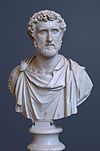
|
Antoninus Pius CAESAR TITVS AELIVS HADRIANVS ANTONINVS AVGVSTVS PIVS |
September 19, 86 AD, Near Lanuvium, Italia | July 10, 138 AD – March 7, 161 AD | Adopted son and heir of Hadrian | March 7, 161 AD Natural causes |

|
Lucius Verus CAESAR LVCIVS AVRELIVS VERVS AVGVSTVS |
December 15, 130 AD, Rome | March 7, 161 AD – ? March 169 AD | Adopted son and heir of Antoninus Pius; Co-emperor with Marcus Aurelius until death | March 169 AD Natural causes (Plague) |
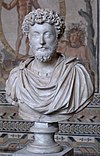
|
Marcus Aurelius CAESAR MARCVS AVRELIVS ANTONINVS AVGVSTVS |
April 26, 121 AD, Rome | March 7, 161 AD – March 17, 180 AD | Adopted son and heir of Antoninus Pius; Co-emperor with Lucius Verus until 169 AD | March 17, 180 AD Natural causes |

|
Commodus CAESAR MARCVS AVRELIVS COMMODVS ANTONINVS AVGVSTVS |
August 31, 161 AD, Lanuvium, Italia | 177 AD – December 31, 192 AD | Natural son of Marcus Aurelius; joint emperor from 177 AD | December 31, 192 AD Assassinated in palace, strangled to death |
Year of the Five Emperors & Severan dynasty
| Portrait | Name | Born | Reigned | Succession | Died |
|---|---|---|---|---|---|

|
Pertinax CAESAR PVBLIVS HELVIVS PERTINAX AVGVSTVS |
August 1, 126 AD, Alba, Italia | January 1, 193 AD – March 28, 193 AD | Proclaimed emperor by Praetorian Guard | March 28, 193 AD Murdered by Praetorian Guard |
| File:DidiusJulianusBust.jpg | Didius Julianus CAESAR MARCVS DIDIVS SEVERVS IVLIANVS AVGVSTVS |
133 or 137 AD, Milan, Italia | March 28, 193 AD – June 1, 193 AD | Won auction held by the Praetorian Guard for the position of emperor | June 1, 193 AD Executed on orders of the Senate |

|
Septimius Severus CAESAR LVCIVS SEPTIMIVS SEVERVS PERTINAX AVGVSTVS |
April 11, 145 AD, Leptis Magna, Africa | April 9, 193 AD – February 4, 211 AD | Seized power with support of Pannonian legionsa | February 4, 211 AD Natural causes |

|
Caracalla CAESAR MARCVS AVRELIVS SEVERVS ANTONINVS PIVS AVGVSTVS |
April 4, 188 AD, Lugdunum, Gallia Lugdunensis | 198 AD – April 8, 217 AD | Son of Septimius Severus; co-emperor with Severus from 198 AD; with Severus and Geta from 209 AD until February 211 AD; co-emperor with Geta until December 211 AD | April 8, 217 AD Murdered by a soldier; probably as part of a conspiracy involving Macrinus |

|
Geta CAESAR PVBLIVS SEPTIMIVS GETA AVGVSTUS |
March 7, 189 AD, Rome | 209 AD – December 26, 211 AD | Son of Septimius Severus; co-emperor with Severus and Caracalla from 209 AD until February 211 AD; co-emperor with Caracalla until December 211 AD | December 26, 211 AD Murdered on the orders of Caracalla |
| File:MacrinusBust.jpg | Macrinus MARCVS OPELLIVS SEVERVS MACRINVS AVGVSTVS PIVS FELIX with Diadumenian MARCVS OPELLIVS ANTONINVS DIADUMENIANUVS |
c. 165 AD, Iol Caesarea, Mauretania | April 11, 217 AD – June 8, 218 AD | Praetorian Prefect to Caracalla, probably conspired to have Caracalla murdered and proclaimed himself emperor after Caracalla's death; appointed his son Diadumenian junior emperor in May 217 | June 8, 218 AD Both executed in favour of Elagabalus |
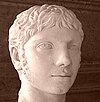
|
Elagabalus MARCVS AVRELIVS ANTONINVS AVGVSTVS |
c. 203 AD, Emesa, Syria | June 8, 218 AD – March 11, 222 AD | Grandson of Septimius Severus's sister-in-law, alleged illegitimate son of Caracalla; proclaimed emperor by Syrian legions | March 11, 222 AD Murdered by Praetorian Guard |
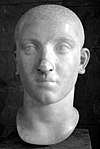
|
Alexander Severus CAESAR MARCVS AVRELIVS SEVERVS ALEXANDER AVGVSTVS |
October 1, 208 AD, Arca Caesarea, Iudaea | March 13, 222 AD – March 18, 235 AD | Grandson of Septimius Severus's sister-in-law, cousin and adoptive heir of Elagabalus | March 18, 235 AD Murdered by the army |
| Notes | aThe other claimants for the throne in the Year of the Five Emperors were Pescennius Niger and Clodius Albinus, supported by the Syrian and British legions respectively. Although not completely defeated until 197 AD, they were not formally accepted by the senate and were therefore not technically reigning emperors. | ||||
Emperors during the Crisis of the Third Century
| Portrait | Name | Born | Reigned | Succession | Died |
|---|---|---|---|---|---|
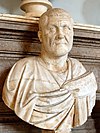
|
Maximinus Thrax CAESAR GAIVS JVLIVS VERVS MAXIMINVS AVGVSTVS |
c.173 AD, Thrace or Moesia | March 20, 235 AD – April 238 AD | Proclaimed emperor by German legions after the murder of Alexander Severus | April 238 AD Assassinated by Praetorian Guard |

|
Gordian I CAESAR MARCVS ANTONIVS GORDIANVS SEMPRONIANVS AFRICANVS AVGVSTVS |
c. 159 AD, Phrygia? | March 22, 238 AD – April 12, 238 AD | Proclaimed emperor, whilst Pro-consul in Africa, during a revolt against Maximinus. Ruled jointly with his son Gordian II, and in opposition to Maximinus. Technically a usurper, but retrospectively legitimised by the accession of Gordian III | April 238 AD Committed suicide upon hearing of the death of Gordian II. |
| Gordian II CAESAR MARCVS ANTONIVS GORDIANVS SEMPRONIANVS ROMANVS AFRICANVS AVGVSTVS |
c. 192 AD, ? | March 22, 238 AD – April 12, 238 AD | Proclaimed emperor, alongside father Gordian I, in opposition to Maximinus. Technically a usurper, but retrospectively legitimised by the accession of Gordian III | April 238 AD Killed during the Battle of Carthage, fighting a pro-Maximinus army | |
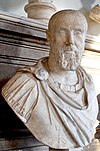
|
Pupienus Maximus CAESAR MARCVS CLODIVS PVPIENVS MAXIMVS AVGVSTVS |
c. 178 AD, ? | April 22, 238 AD – July 29, 238 AD | Proclaimed joint emperor with Balbinus by the Senate in opposition to Maximinus; later co-emperor with Balbinus and Gordian III | July 29, 238 AD Assassinated by the Praetorian Guard |

|
Balbinus CAESAR DECIMVS CAELIVS CALVINVS BALBINVS PIVS AVGVSTVS |
? | April 22, 238 AD – July 29, 238 AD | Proclaimed joint emperor with Pupienus by the Senate after death of Gordian I & II, in opposition to Maximinus; later co-emperor with Pupienus and Gordian III | July 29, 238 AD Assassinated by Praetorian Guard |
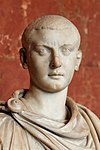
|
Gordian III CAESAR MARCVS ANTONIVS GORDIANVS AVGVSTVS |
January 20, 225 AD, Rome | April 22, 238 AD – February 11, 244 AD | Proclaimed emperor by supporters of Gordian I & II, then by the Senate; joint-emperor with Pupienus and Balbinus until July 238 AD. | February 11, 244 AD Unknown; possibly murdered on orders of Philip the Arab |

|
Philip the Arab CAESAR MARCVS IVLIVS PHILLIPVS AVGVSTVS with Philippus II |
c. 204 AD, Shahba, Syria | February 244 AD – September/October 249 AD | Praetorian Prefect to Gordian III, took power after his death; made his son Philip II co-emperor in summer 247 AD | September/October 249 AD Killed in battle against Decius, near Verona |
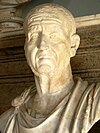
|
Decius CAESAR GAIVS MESSIVS QVINTVS TRAIANVS DECIVS AVGVSTVS with Herennius Etruscus |
c. 201 AD, Budalia, Lower Pannonia | September/ October 249 AD – June 251 AD | Governor under Philip the Arab; proclaimed emperor by Danubian legions and defeated Philip in battle; made his son Herennius Etruscus co-emperor in early 251 AD | June 251 AD Both killed in the Battle of Abrittus fighting against the Goths |
| File:082 Hostilianus.jpg | Hostilian CAESAR CAIVS VALENS HOSTILIANVS MESSIVS QVINTVS AVGVSTVS |
Rome | June 251 AD – late 251 AD | Son of Decius, accepted as heir by the Senate | September/October 251 AD Natural causes (Plague) |

|
Trebonianus Gallus CAESAR GAIVS VIBIVS TREBONIANVS GALLVS AVGVSTVS with Volusianus |
206 AD, Italia | June 251 AD – August 253 AD | Governor of Moesia Superior, proclaimed emperor by Danubian legions after Decius's death (and in opposition to Hostilian); made his son Volusianus co-emperor in late 251 AD. | August 253 AD Assassinated by their own troops, in favour of Aemilianus |
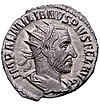
|
Aemilianus CAESAR MARCVS AEMILIVS AEMILIANVS AVGVSTVS |
c. 207 AD Africa | August 253 AD – October 253 AD | Governor of Moesia Superior, proclaimed emperor by Danubian legions after defeating the Goths; accepted as emperor after death of Gallus | September/October 253 AD Assassinated by his own troops, in favour of Valerian |

|
Valerian CAESAR PVBLIVS LICINIVS VALERIANVSAVGVSTVS |
c. 200 AD | October 253 AD – 260 AD | Governor of Noricum and Raetia, proclaimed emperor by Rhine legions after death of Gallus; accepted as emperor after death of Aemilianus | After 260 AD Captured in Battle of Edessa against Persians, died in captivity |

|
Gallienus CAESAR PVBLIVS LICINIVS EGNATIVS GALLIENVS AVGVSTVS with Saloninus |
? | October 253 AD – September 268 AD | Son of Valerian, made co-emperor in 253 AD; his son is very briefly co-emperor in c. July before assassination by Postumus. | September 268 AD Murdered in unclear circumstances |
| File:104 Claudius II Gothicus.jpg | Claudius Gothicus CAESAR MARCVS AVRELIVS CLAVDIVS AVGVSTVS |
May 10, 213 AD/214 AD, Sirmium | September 268 AD – January 270 AD | Victorious general at Battle of Naissus, seized power after Gallienus's death | January 270 AD Natural causes (Plague) |

|
Quintillus CAESAR MARCVS AVRELIVS CLAVDIVS QVINTILLVS AVGVSTVS |
?, Sirmium | January 270 AD – 270 AD | Brother of Claudius Gothicus, seized power after his death | 270 AD Unclear; possibly suicide or murder |

|
Aurelian CAESAR LVCIVS DOMITIVS AVRELIANVS AVGVSTVS |
September 9, 214 AD/215 AD, Sirmium | September(?) 270 AD – September 275 AD | Proclaimed emperor by Danubian legions after Claudius Gothicus's death, in opposition to Quintillus | September 275 AD Assassinated by Praetorian Guard |

|
Tacitus CAESAR MARCVS CLAVDIVS TACITVS AVGVSTVS |
c. 200, Interamna | September 25, 275 AD – June 276 AD | Elected by the Senate to replace Aurelian, after a short interregnum | June 276 AD Natural causes (possibly assassinated) |
| Florianus CAESAR MARCVS ANNIVS FLORIANVS AVGVSTVS |
? | June 276 AD – September? 276 AD | Possibly half-brother of Tacitus, elected by the army in the west to replace him | September? 276 AD Assassinated by his own troops, in favour of Probus | |

|
Probus CAESAR MARCVS AVRELIVS PROBVS AVGVSTVS |
232 AD, Sirmium | September? 276 AD – September/ October 282 AD | Governor of the eastern provinces, proclaimed emperor by Danubian legions in opposition to Florianus | September/ October 282 AD Assassinated by his own troops, in favour of Carus |

|
Carus CAESAR MARCVS AVRELIVS CARVS AVGVSTVS |
c. 230 AD, Narbo | September/ October 282 AD – late July/ early August 283 AD | Praetorian Prefect to Probus; seized power either before or after Probus was murdered | Late July/early August 283 AD Natural causes? (Possibly killed by lightning) |
| File:Numerian.jpg | Numerian CAESAR MARCVS AVRELIVS NVMERIVS NVMERIANVS AVGVSTVS |
? | Late July/early August 283 AD – 284 AD? | Son of Carus, succeeded him jointly with his brother Carinus | 284 AD Unclear; possibly assassinated |

|
Carinus CAESAR MARCVS AVRELIVS CARINVS AVGVSTVS |
? | Late July/early August 283 AD – 285 AD | Son of Carus, succeeded him jointly with his brother Numerian | 285 AD Died in battle against Diocletian? |
The Dominate
Tetrarchy and Constantinian dynasty
| Portrait | Name | Born | Reigned | Succession | Died |
|---|---|---|---|---|---|

|
Diocletian CAESAR GAIVS AVRELIVS VALERIVS DIOCLETIANVS AVGVSTVS |
c. December 22, 244 AD, Salona | November 20, 284 AD – May 1, 305 AD | Proclaimed emperor by army after death of Numerian, and in opposition to Carinus; adopted Maximian as senior co-emperor in 286 AD | 3 December 311 AD Abdicated; died of natural causes in Aspalatos |
| File:MaximianBust.jpg | Maximian CAESAR GAIVS AVRELIVS VALERIVS MAXIMIANVS AVGVSTVS |
c. 250 AD, near Sirmium, Pannonia | April 1, 286 AD – May 1, 305 AD | Adopted as senior co-emperor ('Augustus') in the west by Diocletian in 286 AD | 310 AD Abdicated with Diocletian; twice tried to regain throne with, and then from Maxentius; captured by Constantine I and committed suicide at his behest |
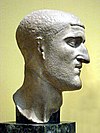
|
Constantius I Chlorus CAESAR GAIVS FLAVIVS VALERIVS CONSTANTIVS AVGVSTVS |
March 31 c. 250 AD, Dardania, Moesia | May 1, 305 AD – July 25, 306 AD | Adopted as junior co-emperor ('Caesar') and heir by Maximian in 293 AD | 306 AD Natural causes |
| Galerius CAESAR GALERIVS VALERIVS MAXIMIANVS AVGVSTVS |
c. 260 AD, Felix Romuliana, Moesia Superior | May 1, 305 AD – May 311 AD | Adopted as junior co-emperor ('Caesar') and heir by Diocletian in 293 AD | 311 AD Natural causes | |

|
Flavius Valerius Severus FLAVIVS VALERIVS SEVERVS AVGVSTVS |
? | Summer 306 AD – March/ April 307 AD | Adopted as junior co-emperor ('Caesar') and heir by Constantius I Chlorus in 305 AD; succeeded as Augustus in 306; opposed by Maxentius and Constantine I | September 16, 307 AD Captured by Maxentius and forced to commit suicide (or murdered) |

|
Constantine I CAESAR FLAVIVS CONSTANTINVS VALERIVS AVGVSTVS |
February 27 c. 272 AD, Naissus, Moesia Superior | 25 July 306 AD – May 22, 337 AD | Son of Constantius I Chlorus, proclaimed emperor by his father's troops; accepted as Caesar (west) by Galerius in 306 AD; promoted to Augustus (west) in 307 AD by Maximian after death of Severus; refused relegation to Caesar in 309 AD | May 22, 337 AD Natural causes |
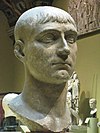
|
Maxentius MARCVS AVRELIVS VALERIVS MAXENTIVS AVGVSTVS |
c. 278 AD, ? | 28 October 306 AD – October 28, 312 AD | Son of Maximian, seized power in 306 after death of Constantius I Chlorus, in opposition to Severus and Constantine I; made Caesar (west) by Maximian in 307 AD after the death of Severus | October 28, 312 AD Died at the Battle of the Milvian Bridge, against Constantine I |
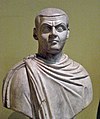
|
Maximinus Daia CAESAR GALERIVS VALERIVS MAXIMINVS AVGVSTVS |
November 20 c. 270 AD, Dacia Aureliana | May 1, 311 AD – July/August 313 AD | Nephew of Galerius, adopted as Caesar and his heir in 305 AD; succeeded as Augustus (shared with Licinius) in 311 AD | July/August 313 AD Defeated in civil war against Licinius; probably committed suicide thereafter |

|
Licinius CAESAR GAIVS VALERIVS LICINIVS AVGVSTVS with Valerius Valens Martinianus |
c. 250 AD, Felix Romuliana, Moesia Superior | November 11, 308 AD – September 18, 324 AD | Appointed Augustus in the west by Galerius in 308 BC, in opposition to Maxentius; became Augustus in the east in 311 AD after the death of Galerius (shared with Maximinus); defeated Maximinus in civil war to become sole eastern Augustus in 313 BC; appointed Valerius Valens in 317 AD, and Martinianus in 324 AD as western Augustus, in opposition to Constantine, both nominally ruled for a few months before being executed | 325 AD Defeated in civil war against Constantine I in 324 AD and captured; executed on the orders of Constantine the next year |

|
Constantine II CAESAR FLAVIVS CLAVDIVS CONSTANTINVS AVGVSTVS |
316 AD, Arles | May 22, 337 AD – 340 AD | Son of Constantine I; appointed Caesar in 317 AD, succeeded as joint Augustus with his brothers Constantius II and Constans I | 340 AD Died in battle against Constans I |
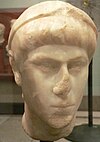
|
Constantius II CAESAR FLAVIVS IVLIVS CONSTANTIVS AVGVSTVS |
August 7, 317 AD, Sirmium, Pannonia | May 22, 337 AD – November 3, 361 AD | Son of Constantine I; succeeded as joint Augustus with his brothers Constantine II and Constans I; sole emperor from 350 AD | 361 AD Natural causes |
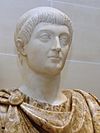
|
Constans I CAESAR FLAVIVS IVLIVS CONSTANS AVGVSTVS |
320 AD, ? | May 22, 337 AD – 350 AD | Son of Constantine I; succeeded as joint Augustus with his brothers Constantine II and Constantius II | 350 AD Assassinated on the orders of the usurper Magnentius |

|
Vetranio | ?, Moesia | March 1 – December 25, 350 AD | General of Constans I, proclaimed Caesar against Magnentius and temporally accepted as Augustus of the west by Constantius II. | c. 356 As a private citizen, after abdication. |
| File:JulianStatue.jpg | Julian CAESAR FLAVIVS CLAVDIVS IVLIANVS AVGVSTVS |
331 AD/332 AD, Constantinople, Thracia | February 360 AD – June 26, 363 AD | Cousin of Constantius II; made Caesar of the west in 355 AD; proclaimed Augustus by his troops in 360; sole emperor after the death of Constantius | June 26, 363 AD Mortally wounded in battle |

|
Jovianus CAESAR FLAVIVS IOVIANVS AVGVSTVS |
331 AD, Singidunum, Moesia | June 26, 363 AD – February 17, 364 AD | General of Julian's army; proclaimed emperor by the troops on Julian's death | February 17, 364 AD Natural causes (suffocated on fumes) |
Valentinian dynasty
| Portrait | Name | Born | Reigned | Succession | Died |
|---|---|---|---|---|---|
| File:ValentinianI.PNG | Valentinian I FLAVIVS VALENTINIANVS AVGVSTVS |
321 AD, Cibalae, Pannonia | February 26, 364 AD – November 17, 375 AD | Elected to replace Jovian by the army | November 17, 375 AD Natural causes |
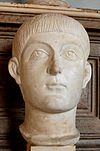
|
Valens FLAVIVS IVLIVS VALENS AVGVSTVS |
328 AD, Cibalae, Pannonia | March 28, 364 AD – August 9, 378 AD | Brother of Valentinian I, appointed co-augustus (for the east) by him | August 9, 378 AD Killed in Battle of Adrianople against the Goths |
| File:TGratian.png | Gratian FLAVIVS GRATIANVS AVGVSTVS |
April 18/May 23, 359 AD, Sirmium, Pannonia | August 4, 367 AD – August 25, 383 AD | Son of Valentinian I, appointed 'junior' Augustus by him in 367, became 'senior' augustus (for the west) after Valentinian's death. | August 25, 383 AD Murdered by rebellious army faction |
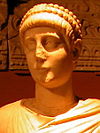
|
Valentinian II FLAVIVS VALENTINIANVS INVICTVS AVGVSTVS |
371 AD, Milan, Italia | November 17, 375 AD – May 15, 392 AD | Son of Valentinian I, proclaimed emperor by Pannonian army after Valentinian's death; accepted as co-Augustus for the west by Gratian | May 15, 392 AD Unclear; possibly murdered or committed suicide |
Theodosian dynasty
| Portrait | Name | Born | Reigned | Succession | Died |
|---|---|---|---|---|---|
| File:Theodosius-1-.jpg | Theodosius I FLAVIVS THEODOSIVS AVGVSTVS |
January 11, 347 AD, Cauca, Hispania | January 1, 379 AD – January 17, 395 AD | Appointed as Augustus for the east by Gratian after the death of Valens; became sole 'senior' Augustus after death of Valentinian II | January 17, 395 AD Natural causes |
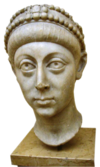
|
Arcadius FLAVIVS ARCADIVS AVGVSTVS EAST |
c. 377 AD, Hispania | January 383 AD – May 1, 408 AD | Son of Theodosius I; appointed as 'junior' Augustus for the east by Theodosius in 383 (after the death of Gratian); became 'senior' Augustus for the east after his father's death | May 1, 408 AD Natural causes |
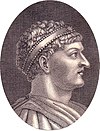
|
Honorius FLAVIVS HONORIVS AVGVSTVS WEST |
September 9, 384 AD, ? | January 23, 393 AD – August 15, 423 AD | Son of Theodosius I; appointed as 'junior' Augustus for the west by Theodosius in 393 (after the death of Valentinian II); became 'senior' Augustus for the west after his father's death | August 15, 423 AD Natural causes |

|
Theodosius II FLAVIVS THEODOSIVS AVGVSTVS EAST |
April 10, 401 AD, Constantinople? | May 1, 408 AD – July 28, 450 AD | Son of Arcadius, succeeded to the throne after his father's death | July 28, 450 AD Natural causes |
| Constantius III FLAVIVS CONSTANTIVS AVGVSTVS WEST |
?, Naissus, Moesia Superior | February 8, 421 AD – September 2, 421 AD | Married to Theodosius I's daughter Galla Placidia, elevated to co-Augustus for the west by Honorius | September 2, 421 AD Natural causes | |
| Joannes WEST |
? | August 27, 423 AD – May 425 AD | A senior civil servant under Honorius, proclaimed emperor by Castinus; initially undisputed | June or July 425 AD Defeated in battle by Theodosius II and Valentinian III, captured and executed | |

|
Valentinian III FLAVIVS PLACIDIVS VALENTINIANVS AVGVSTVS WEST |
July 2, 419 AD, Ravenna, Italia | October 23, 424 AD – March 16, 455 AD | Son of Constantius III, appointed Caesar for the west by Theodosius II after the death of Honorius, in opposition to the Joannes; became Augustus for the west after the defeat of Joannes | March 16, 455 AD Assassinated, possibly at the behest of Petronius Maximus |
| Marcian FLAVIVS MARCIANIVS AVGVSTVS EAST |
396, Thrace or Illyria | Summer 450 AD – January 457 AD | Nominated as successor (and husband) by Pulcheria, sister of Theodosius II | January 457 AD Natural causes |
The last emperors of the Western Empire
| Portrait | Name | Born | Reigned | Succession | Died |
|---|---|---|---|---|---|
| Petronius Maximus FLAVIVS ANICIVS PETRONIVS MAXIMVS AVGVSTVS |
c. 396 AD, ? | March 17, 455 AD – May 31, 455 AD | Proclaimed himself emperor with the support of the army, after the death of Valentinian III | May 31, 455 AD Murdered, probably stoned to death by the Roman mob | |
| Avitus EPARCHIVS AVITVS AVGVSTVS |
c. 385 AD, ? | July 9, 455 AD – October 17, 456 AD | Magister militum under Petronius Maximus, proclaimed emperor by the Visigoth king Theoderic II after Petronius's death | after 17 October 456 AD Deposed by his Magister militum, Ricimer; became bishop of Placentia; murdered at some point afterwards | |

|
Majorian IVLIVS VALERIVS MAIORIANVS AVGVSTVS |
November 420 AD, ? | April 457 AD – August 2, 461 AD | Appointed emperor by Ricimer | August 7, 461 AD Deposed by his troops (probably at the behest of Ricimer); died shortly afterwards in unclear circumstances |

|
Libius Severus LIBIVS SEVERVS AVGVSTVS |
?, Lucania, Italia | November 461 AD – August 465 AD | Appointed emperor by Ricimer | August 465 AD Probably assassinated by Ricimer |

|
Anthemius PROCOPIVS ANTHEMIVS AVGVSTVS |
c. 420 AD | April 12, 467 AD – July 11, 472 AD | Appointed emperor by Ricimer, with the backing of the eastern emperor Leo I | July 11, 472 AD Executed by Ricimer |

|
Olybrius FLAVIVS ANICIVS OLYBRIVS AVGVSTVS |
c. 420 AD | July 11, 472 AD – November 2, 472 AD | Son-in-law of Valentinian III; appointed emperor by Ricimer | November 2, 472 AD Natural causes |

|
Glycerius | ? | March 473 AD – June 474 AD | Appointed emperor by Gundobad (Ricimer's successor) | after 480 AD Deposed by Julius Nepos, became Bishop of Salona, time and manner of death unknown |

|
Julius Nepos | c. 430 AD, ? | June 474 AD – August 28, 475 AD (in Italy); – Spring 480 AD (in Gaul and Dalmatia) | Nephew-in-law of the eastern emperor Leo I, appointed emperor in opposition to Glycerius | 480 AD Deposed in Italy by Flavius Orestes, ruled in exile until assassination in 480 |

|
Romulus Augustulus | ? | October 31, 475 AD – September 4, 476 AD (in Italy) | Appointed by his father, Flavius Orestes | after 480 AD Deposed by Odoacer, who then ruled in the name of Julius Nepos until the latter's death, which formally ended the western empire; most likely lived out his life on a private villa in obscurity |
The Emperors of the Eastern Empire
Leonid Dynasty
| Portrait | Name | Born | Reigned | Succession | Died |
|---|---|---|---|---|---|

|
Leo I FLAVIVS VALERIVS LEO AVGVSTVS |
401 AD, ? | February 7, 457 AD – January 18, 474 AD | Proclaimed emperor by the Magister militum Aspar after Marcian's death | January 18, 474 AD Natural causes |

|
Leo II FLAVIVS LEO IVNIOR AVGVSTVS |
467 AD, Constantinople? | January 18, 474 AD – November 17, 474 AD | Grandson of Leo I by his daughter Ariadne (empress) | November 17, 474 AD Unclear, possibly assassinated |

|
Zeno FLAVIVS ZENO PERPETVVS AVGVSTVS |
425 AD, Isauria | February 9, 474 AD – January 9, 475 AD & August 476 AD – April 9, 491 AD |
Father of Leo II | April 9, 491 AD Natural causes |
| Basiliscus FLAVIVS BASILISCVS AVGVSTVS |
? | January 9, 475 AD – August 476 AD | Brother-in-law of Leo I, seized power during a plot against Zeno by Verina (Leo I's widow and Basiliscus's sister) | August 476 AD Defeated, captured and executed by Zeno | |

|
Anastasius I FLAVIVS ANASTASIVS AVGVSTVS |
c. 430 AD, Dyrrachium | April 9, 491 AD – July 9, 518 AD | Selected by Ariadne as successor to Zeno (as both emperor and husband) | July 9, 518 Natural causes |
Justinian Dynasty
| Portrait | Name | Born | Reigned | Succession | Died |
|---|---|---|---|---|---|
| Justin I FLAVIVS IVSTINVS AVGVSTVS |
c. 450 AD, Naissus | July 9, 518 AD – August 1, 527 AD | Commander of the palace guard under Anastasius I); elected as emperor with support of army | August 1, 527 AD Natural causes | |
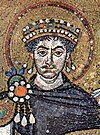
|
Justinian I FLAVIVS PETRVS SABBATIVS IVSTINIANVS AVGVSTVS |
c. 482 AD, Tauresium, Dardania | August 1, 527 AD – 13/14 November 565 AD | Nephew and nominated heir of Justin I | 13/14 November 565 AD Natural causes |
| Justin II FLAVIVS IVSTINIVS IVNIOR AVGVSTVS |
c. 520 AD, ? | 13/14 November 565 AD – 578 AD | Nephew of Justinian I | 578 AD Became insane; Tiberius II Constantine ruled as regent from December 574 and became emperor on Justin's death in 578 |
- Continue to List of Byzantine Emperors
Timeline
Timeline indicating the chronological life-spans of the Roman Emperors

See also
References
- Chris Scarre,Brandon Shaw, Chronicle of the Roman Emperors, Thames & Hudson, 1995, Reprinted 2001, ISBN 0-500-05077-5
- Tacitus, The Annals of Imperial Rome, Penguin Classics, Michael Grant Publications Ltd, 1971, Reprinted 1985, ISBN 0-14-044060-7
- Martha Ross, Rulers and Governments of the World, Vol.1 Earliest Times to 1491, Bowker, 1978, ISBN 0-85935-021-5
- Clive Carpenter, The Guinness Book of Kings Rulers & Statesmen, Guinness Superlatives Ltd, 1978, ISBN 0-900424-46-X
- R.F.Tapsell, Monarchs Rulers Dynasties and Kingdoms of The World, Thames & Hudson, 1981, Reprinted 1987, ISBN 0-500-27337-5
- ^ a b Rubicon. Holland, T. Abacus, 978-0349115634
- ^ Chester G. Starr, A History of the Ancient World, Second Edition. Oxford University Press, 1974. pp. 670–678.
- ^ Asimov, p. 198.
External links
- Biographies of Roman Emperors.
- List of the Roman Emperors 27 BC – 395 AD
- Portraits and fact files
- The Roman Law Library by Yves Lassard and Alexandr Koptev.
- Timeline of Roman Emperors and Empresses
